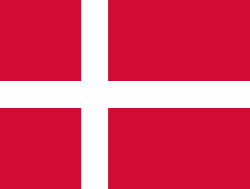Kingdom of Denmark
Related Categories:
 Danish National Symbols - Embassy of Denmark Washington
Danish National Symbols - Embassy of Denmark WashingtonRead about the Danish flag, the national anthems, coats of arms, orders of chivalry, national dress and folk dancing and other national symbols of Denmark.
www.ambwashington.um.dk/
The Danish flag is called "Dannebrog", which is old Danish for "The Danish Cloth".
www.fotw.us/
Denmark borders both the Baltic and the North Sea. The country consists of a large peninsula, Jutland, which borders northern Germany, plus a large number of islands, most notably Zealand, Funen, Vendsyssel-Thy, Lolland and Bornholm as well as hundreds of minor islands often referred to as the Danish Archipelago.
en.wikipedia.org/
The Danes, a homogenous Gothic-Germanic people, have inhabited Denmark since prehistoric times. Danish is the principal language. English is a required school subject, and fluency is high. A small German-speaking minority lives in southern Jutland; a mostly Inuit population inhabits Greenland; and the Faroe Islands have a Nordic population with its own language. Education is compulsory from ages seven to 16 and is free through the university level.
Although religious freedom is guaranteed, the state-supported Evangelical Lutheran Church accounts for about 95% of those persons claiming religious affiliation. Several other Christian denominations, as well as other major religions, find adherents in Denmark. Islam is now the second-largest religion in Denmark.
During the Viking period (9th-11th centuries), Denmark was a great power based on the Jutland Peninsula, the Island of Zealand, and the southern part of what is now Sweden. In the early 11th century, King Canute united Denmark and England for almost 30 years.
Viking raids brought Denmark into contact with Christianity, and in the 12th century, crown and church influence increased. By the late 13th century, royal power had waned, and the nobility forced the king to grant a charter, considered Denmark's first constitution. Although the struggle between crown and nobility continued into the 14th century, Queen Margrethe I succeeded in uniting Denmark, Norway, Sweden, Finland, the Faroe Islands, Iceland, and Greenland under the Danish crown. Sweden and Finland left the union in 1520; however, Norway remained until 1814. Iceland, in a "personal union" under the king of Denmark after 1918, became independent in 1944.
The Reformation was introduced in Denmark in 1536. Denmark's provinces in today's southwestern Sweden were lost in 1658, and Norway was transferred from the Danish to the Swedish crown in 1814, following the defeat of Napoleon, with whom Denmark was allied.
The Danish liberal movement gained momentum in the 1830s, and in 1849 Denmark became a constitutional monarchy. After the war with Prussia and Austria in 1864, Denmark was forced to cede Schleswig-Holstein to Prussia and adopt a policy of neutrality. Toward the end of the 19th century, Denmark inaugurated important social and labor market reforms, laying the basis for the present welfare state.
Denmark remained neutral during World War I. Despite its declaration of neutrality at the beginning of World War II, it was invaded by the Germans in 1940 and occupied until liberated by the Allied forces in May 1945. Resistance against the Germans was sporadic until late 1943. By then better organized, the resistance movement and other volunteers undertook a successful rescue mission in which nearly the entire Jewish population of Denmark was shipped to Sweden (whose neutrality was honored by Germany). However, extensive studies are still undertaken for the purpose of establishing a clearer picture of the degree of Danish cooperation--official and corporate--with the occupying power. Denmark became a charter member of the United Nations and was one of the original signers of the North Atlantic Treaty.
www.state.gov/r/
Introduction
About
Contact
Symbols in The News
Interpret this Symbol
AAC
African
AI
Alchemy
Alphabets
Ancient
Animal Symbolism
Architecture
Art
Articles
Astrology
Baha'i
Blissymbolics
Blueprint Symbols
Buddhist
Celtic Symbols
Cemetery
Chinese Symbols
Christian
Circle
City
Codes
Color
Conlangs
Crop Circles
Danger
Da Vinci Code
Designing Logos
Dictionaries
Dreams
Education
Egyptian Symbols
Electrical
Emoticons
Find Images
Fonts
Food
Fraternity
Hamsa
Healing
Heraldry
Hermetic
Highway Signs
Hindu
History
Hobo
Holiday
Icons
iConji
Islamic
Jain Symbols
Japanese, Kanji
Jewish
Justice
Law
Literary Symbolism
Mandalas
Map
Masonic
Math, Number
Meaning of Names
Medical
Middle East
Military
Miscellaneous
Money
Music
Mythology
Native American
Playing Cards
Power
Psychology
QiQiiKhu
Reiki
Religious
Runes, Norse
Sacred Geometry
Scientific
Science Fiction
Sorority
Sports
Symbols in the News
Tattoos
ThirteenSymbols
Tree of Life
Ursprache
Videos
Visual Languages
Weather
Web Codes
Wicca
Words
Writing Systems
Braille
Coinherence
Coptic
Cuneiform
Easter Island
Etruscan
Happy Human
Hebrew
Kokopelli
Linear B
Lotus
Love Symbols
Mandorla
Moon Alphabet
Nine Pointed Star
Om
Oz
Phonetic
Scarab Beetle
Silent
Theosophy
Unifon
About
Contact
Symbols in The News
Interpret this Symbol
AAC
African
AI
Alchemy
Alphabets
Ancient
Animal Symbolism
Architecture
Art
Articles
Astrology
Baha'i
Blissymbolics
Blueprint Symbols
Buddhist
Celtic Symbols
Cemetery
Chinese Symbols
Christian
Circle
City
Codes
Color
Conlangs
Crop Circles
Danger
Da Vinci Code
Designing Logos
Dictionaries
Dreams
Education
Egyptian Symbols
Electrical
Emoticons
Find Images
Fonts
Food
Fraternity
Hamsa
Healing
Heraldry
Hermetic
Highway Signs
Hindu
History
Hobo
Holiday
Icons
iConji
Islamic
Jain Symbols
Japanese, Kanji
Jewish
Justice
Law
Literary Symbolism
Mandalas
Map
Masonic
Math, Number
Meaning of Names
Medical
Middle East
Military
Miscellaneous
Money
Music
Mythology
Native American
Playing Cards
Power
Psychology
QiQiiKhu
Reiki
Religious
Runes, Norse
Sacred Geometry
Scientific
Science Fiction
Sorority
Sports
Symbols in the News
Tattoos
ThirteenSymbols
Tree of Life
Ursprache
Videos
Visual Languages
Weather
Web Codes
Wicca
Words
Writing Systems
Braille
Coinherence
Coptic
Cuneiform
Easter Island
Etruscan
Happy Human
Hebrew
Kokopelli
Linear B
Lotus
Love Symbols
Mandorla
Moon Alphabet
Nine Pointed Star
Om
Oz
Phonetic
Scarab Beetle
Silent
Theosophy
Unifon

